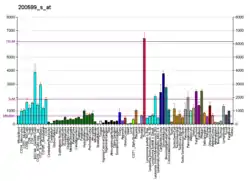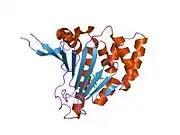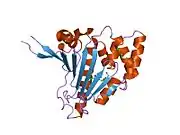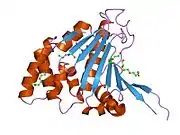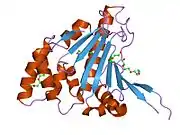Heat shock protein 90kDa beta member 1 (HSP90B1), known also as endoplasmin, gp96, grp94, or ERp99, is a chaperone protein that in humans is encoded by the HSP90B1 gene.[5][6]
HSP90B1 is an HSP90 paralogue that is found in the endoplasmic reticulum. It plays critical roles in folding proteins in the secretory pathway such as Toll-like receptors and integrins.[7][8] It has been implicated as an essential immune chaperone to regulate both innate and adaptive immunity.[9] Tumor-derived HSP90B1 (vitespen) has entered clinical trials for cancer immunotherapy.[10][11][12][13]
grp94 has been shown to be a target for treatment of a plethora of diseases such as glaucoma, multiple myeloma, and metastatic cancer. grp94 includes 5 distinct amino acids in its primary sequence which creates 2 unique sub-pockets, S1 and S2. These sub-pockets have been utilized in current research in order to inhibit the chaperone since its client proteins seem to be up-regulated in cancer cells.[14]
References
- 1 2 3 GRCh38: Ensembl release 89: ENSG00000166598 - Ensembl, May 2017
- 1 2 3 GRCm38: Ensembl release 89: ENSMUSG00000020048 - Ensembl, May 2017
- ↑ "Human PubMed Reference:". National Center for Biotechnology Information, U.S. National Library of Medicine.
- ↑ "Mouse PubMed Reference:". National Center for Biotechnology Information, U.S. National Library of Medicine.
- ↑ Maki RG, Old LJ, Srivastava PK (August 1990). "Human homologue of murine tumor rejection antigen gp96: 5'-regulatory and coding regions and relationship to stress-induced proteins". Proceedings of the National Academy of Sciences of the United States of America. 87 (15): 5658–62. Bibcode:1990PNAS...87.5658M. doi:10.1073/pnas.87.15.5658. PMC 54386. PMID 2377606.
- ↑ Chen B, Piel WH, Gui L, Bruford E, Monteiro A (December 2005). "The HSP90 family of genes in the human genome: insights into their divergence and evolution". Genomics. 86 (6): 627–37. doi:10.1016/j.ygeno.2005.08.012. PMID 16269234.
- ↑ Randow F, Seed B (October 2001). "Endoplasmic reticulum chaperone gp96 is required for innate immunity but not cell viability". Nature Cell Biology. 3 (10): 891–6. doi:10.1038/ncb1001-891. PMID 11584270. S2CID 26559580.
- ↑ Yang Y, Liu B, Dai J, Srivastava PK, Zammit DJ, Lefrançois L, Li Z (February 2007). "Heat shock protein gp96 is a master chaperone for toll-like receptors and is important in the innate function of macrophages". Immunity. 26 (2): 215–26. doi:10.1016/j.immuni.2006.12.005. PMC 2847270. PMID 17275357.,
- ↑ Schild H, Rammensee HG (August 2000). "gp96--the immune system's Swiss army knife". Nature Immunology. 1 (2): 100–1. doi:10.1038/77770. PMID 11248798. S2CID 29571184.
- ↑ Wood CG, Mulders P (August 2009). "Vitespen: a preclinical and clinical review". Future Oncology. 5 (6): 763–74. doi:10.2217/fon.09.46. PMID 19663726.
- ↑ Tosti G, di Pietro A, Ferrucci PF, Testori A (November 2009). "HSPPC-96 vaccine in metastatic melanoma patients: from the state of the art to a possible future". Expert Review of Vaccines. 8 (11): 1513–26. doi:10.1586/erv.09.108. PMID 19863242. S2CID 207223461.
- ↑ "NCT00293423". ClinicalTrials.gov, United States National Institutes of Health. Retrieved 2010-04-10.
GP96 Heat Shock Protein-Peptide Complex Vaccine in Treating Patients With Recurrent or Progressive Glioma
- ↑ Bloch O, Crane CA, Fuks Y, Kaur R, Aghi MK, Berger MS, Butowski NA, Chang SM, Clarke JL, McDermott MW, Prados MD, Sloan AE, Bruce JN, Parsa AT (January 2014). "Heat-shock protein peptide complex-96 vaccination for recurrent glioblastoma: a phase II, single-arm trial". Neuro-Oncology. 16 (2): 274–9. doi:10.1093/neuonc/not203. PMC 3895386. PMID 24335700.
- ↑ Khandelwal A, Crowley VM, Blagg BS (October 2017). "Resorcinol-Based Grp94-Selective Inhibitors". ACS Medicinal Chemistry Letters. 8 (10): 1013–1018. doi:10.1021/acsmedchemlett.7b00193. PMC 5641966. PMID 29057043.
Further reading
- Srivastava P (2001). "Interaction of heat shock proteins with peptides and antigen presenting cells: chaperoning of the innate and adaptive immune responses". Annual Review of Immunology. 20 (1): 395–425. doi:10.1146/annurev.immunol.20.100301.064801. PMID 11861608.
- Li Z, Dai J, Zheng H, Liu B, Caudill M (March 2002). "An integrated view of the roles and mechanisms of heat shock protein gp96-peptide complex in eliciting immune response". Frontiers in Bioscience. 7 (4): d731–51. doi:10.2741/A808. PMID 11861214.
- Dollins DE, Warren JJ, Immormino RM, Gewirth DT (October 2007). "Structures of GRP94-nucleotide complexes reveal mechanistic differences between the hsp90 chaperones". Molecular Cell. 28 (1): 41–56. doi:10.1016/j.molcel.2007.08.024. PMC 2094010. PMID 17936703.
- Kaul SC, Taira K, Pereira-Smith OM, Wadhwa R (2003). "Mortalin: present and prospective". Experimental Gerontology. 37 (10–11): 1157–64. doi:10.1016/S0531-5565(02)00135-3. PMID 12470827. S2CID 44450296.
- Schaiff WT, Hruska KA, McCourt DW, Green M, Schwartz BD (September 1992). "HLA-DR associates with specific stress proteins and is retained in the endoplasmic reticulum in invariant chain negative cells". The Journal of Experimental Medicine. 176 (3): 657–66. doi:10.1084/jem.176.3.657. PMC 2119345. PMID 1512535.
- Zolnierowicz S, Work C, Hutchison K, Fox IH (April 1990). "Partial separation of platelet and placental adenosine receptors from adenosine A2-like binding protein". Molecular Pharmacology. 37 (4): 554–9. PMID 2325637.
- Hutchison KA, Nevins B, Perini F, Fox IH (May 1990). "Soluble and membrane-associated human low-affinity adenosine binding protein (adenotin): properties and homology with mammalian and avian stress proteins". Biochemistry. 29 (21): 5138–44. doi:10.1021/bi00473a020. PMID 2378869.
- Chang SC, Erwin AE, Lee AS (May 1989). "Glucose-regulated protein (GRP94 and GRP78) genes share common regulatory domains and are coordinately regulated by common trans-acting factors". Molecular and Cellular Biology. 9 (5): 2153–62. doi:10.1128/mcb.9.5.2153. PMC 363009. PMID 2546060.
- Anderson SL, Shen T, Lou J, Xing L, Blachere NE, Srivastava PK, Rubin BY (October 1994). "The endoplasmic reticular heat shock protein gp96 is transcriptionally upregulated in interferon-treated cells". The Journal of Experimental Medicine. 180 (4): 1565–9. doi:10.1084/jem.180.4.1565. PMC 2191700. PMID 7523574.
- Bruneau N, Lombardo D (June 1995). "Chaperone function of a Grp 94-related protein for folding and transport of the pancreatic bile salt-dependent lipase". The Journal of Biological Chemistry. 270 (22): 13524–33. doi:10.1074/jbc.270.22.13524. PMID 7768954.
- Chavany C, Mimnaugh E, Miller P, Bitton R, Nguyen P, Trepel J, Whitesell L, Schnur R, Moyer J, Neckers L (March 1996). "p185erbB2 binds to GRP94 in vivo. Dissociation of the p185erbB2/GRP94 heterocomplex by benzoquinone ansamycins precedes depletion of p185erbB2". The Journal of Biological Chemistry. 271 (9): 4974–7. doi:10.1074/jbc.271.9.4974. PMID 8617772.
- Kuznetsov G, Chen LB, Nigam SK (January 1997). "Multiple molecular chaperones complex with misfolded large oligomeric glycoproteins in the endoplasmic reticulum". The Journal of Biological Chemistry. 272 (5): 3057–63. doi:10.1074/jbc.272.5.3057. PMID 9006956.
- Hoshino T, Wang J, Devetten MP, Iwata N, Kajigaya S, Wise RJ, Liu JM, Youssoufian H (June 1998). "Molecular chaperone GRP94 binds to the Fanconi anemia group C protein and regulates its intracellular expression". Blood. 91 (11): 4379–86. doi:10.1182/blood.v91.11.4379. PMID 9596688.
- Linnik KM, Herscovitz H (August 1998). "Multiple molecular chaperones interact with apolipoprotein B during its maturation. The network of endoplasmic reticulum-resident chaperones (ERp72, GRP94, calreticulin, and BiP) interacts with apolipoprotein b regardless of its lipidation state". The Journal of Biological Chemistry. 273 (33): 21368–73. doi:10.1074/jbc.273.33.21368. PMID 9694898.
- Delom F, Lejeune PJ, Vinet L, Carayon P, Mallet B (February 1999). "Involvement of oxidative reactions and extracellular protein chaperones in the rescue of misassembled thyroglobulin in the follicular lumen". Biochemical and Biophysical Research Communications. 255 (2): 438–43. doi:10.1006/bbrc.1999.0229. PMID 10049727.
- Reddy RK, Lu J, Lee AS (October 1999). "The endoplasmic reticulum chaperone glycoprotein GRP94 with Ca(2+)-binding and antiapoptotic properties is a novel proteolytic target of calpain during etoposide-induced apoptosis". The Journal of Biological Chemistry. 274 (40): 28476–83. doi:10.1074/jbc.274.40.28476. PMID 10497210.
- Roher N, Sarno S, Miró F, Ruzzene M, Llorens F, Meggio F, Itarte E, Pinna LA, Plana M (September 2001). "The carboxy-terminal domain of Grp94 binds to protein kinase CK2 alpha but not to CK2 holoenzyme". FEBS Letters. 505 (1): 42–6. doi:10.1016/S0014-5793(01)02781-8. PMID 11557039. S2CID 52949128.
- Vabulas RM, Braedel S, Hilf N, Singh-Jasuja H, Herter S, Ahmad-Nejad P, Kirschning CJ, Da Costa C, Rammensee HG, Wagner H, Schild H (June 2002). "The endoplasmic reticulum-resident heat shock protein Gp96 activates dendritic cells via the Toll-like receptor 2/4 pathway". The Journal of Biological Chemistry. 277 (23): 20847–53. doi:10.1074/jbc.M200425200. PMID 11912201.
- Shin HJ, Kim SS, Cho YH, Lee SG, Rho HM (March 2002). "Host cell proteins binding to the encapsidation signal epsilon in hepatitis B virus RNA". Archives of Virology. 147 (3): 471–91. doi:10.1007/s007050200001. PMID 11958450. S2CID 23653290.






